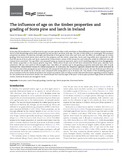| dc.contributor.author | Gil-Moreno, David | |
| dc.contributor.author | Manso, Rubén | |
| dc.contributor.author | O’Ceallaigh, Conan | |
| dc.contributor.author | Harte, Annette M. | |
| dc.date.accessioned | 2023-08-23T07:38:42Z | |
| dc.date.available | 2023-08-23T07:38:42Z | |
| dc.date.issued | 2023-06-13 | |
| dc.identifier.citation | Gil-Moreno, David, Manso, Rubén, O’Ceallaigh, Conan, & Harte, Annette M. (2023). The influence of age on the timber properties and grading of Scots pine and larch in Ireland. Forestry: An International Journal of Forest Research. doi: 10.1093/forestry/cpad027 | en_IE |
| dc.identifier.issn | 1464-3626 | |
| dc.identifier.uri | http://hdl.handle.net/10379/17881 | |
| dc.description.abstract | Scots pine (Pinus sylvestris L.) and larch (Larix spp.) are two species that could contribute to diversifying Ireland’s timber supply. However, there is little knowledge about their properties as well as their variation with age. The aim of this study is to investigate the structural properties (modulus of elasticity, strength and density) of Irish-grown Scots pine and larch and the effect of cambial age on timber grading. Structural-sized pieces were used for this purpose, and the timber properties, knots and ring width were measured on 158 and 250 pieces of Scots pine and larch, respectively. Characteristic values of the properties and indicative yields for different strength classes were calculated. The age effect was assessed using an empirical approach, and a novel modelling approach that disaggregates the timber properties at the annual growth ring level. Yields above 90 per cent of C20 were achieved for Scots pine, whereas larch achieved a 100 per cent yield of C24 strength class. The effect of cambial age in the grading properties indicated that older boards increased the characteristic values of a timber population. In Scots pine, the empirical approach showed that the yields increased by up to 26 per cent when using pieces up to 50 years old compared with pieces up to 30 years old. In larch, the use of pieces up to 40 years old increased the yields by up to 16 per cent compared with using pieces up to 30 years old. The results of the modelling approach were consistent with the values obtained in the empirical analysis and can help to make informed decisions regarding rotation lengths for the production of structural timber. Our results found that cambial ages of 40 years in Scots pine produce high yields of structural timber, whereas 30 years are enough for larch. | en_IE |
| dc.description.sponsorship | Forest Sector Development Division of the Department of Agriculture, Food and the Marine, Ireland [WoodProps]; and the Higher Education Authority and the Department of Further and Higher Education, Research, Innovation and Science [HEA Covid-19 Costed Extension]. | en_IE |
| dc.format | application/pdf | en_IE |
| dc.language.iso | en | en_IE |
| dc.publisher | Oxford University Press | en_IE |
| dc.relation.ispartof | Forestry: An International Journal of Forest Research | en |
| dc.rights | Attribution 4.0 International (CC BY 4.0) | |
| dc.rights.uri | https://creativecommons.org/licenses/by/4.0/ | |
| dc.subject | Scots pine | en_IE |
| dc.subject | Larch | en_IE |
| dc.subject | Strength grading | en_IE |
| dc.subject | Wood properties | en_IE |
| dc.subject | Structural timber | en_IE |
| dc.subject | Cambial age | en_IE |
| dc.title | The influence of age on the timber properties and grading of Scots pine and larch in Ireland | en_IE |
| dc.type | Article | en_IE |
| dc.date.updated | 2023-08-22T22:39:52Z | |
| dc.identifier.doi | 10.1093/forestry/cpad027 | |
| dc.local.publishedsource | https://doi.org/10.1093/forestry/cpad027 | en_IE |
| dc.description.peer-reviewed | peer-reviewed | |
| dc.contributor.funder | Department of Agriculture, Food and the Marine, Ireland | en_IE |
| dc.contributor.funder | Higher Education Authority | en_IE |
| dc.contributor.funder | Department of Further and Higher Education, Research, Innovation and Science | en_IE |
| dc.internal.rssid | 31555100 | |
| dc.local.contact | David Gil-Moreno. Email: david.gil-moreno@nuigalway.ie | |
| dc.local.copyrightchecked | Yes | |
| nui.item.downloads | 143 | |


